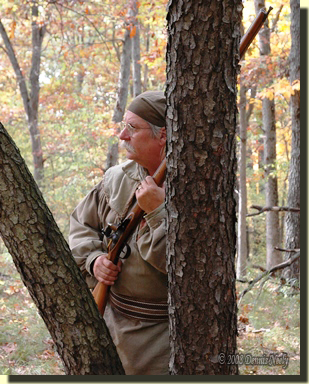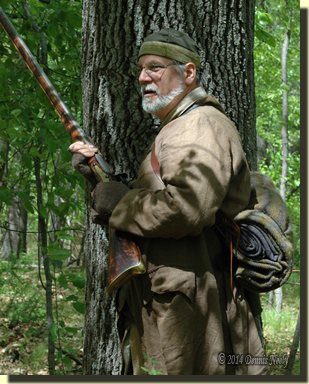Step by step, center-seamed moccasins paralleled the path. The hired post hunter left no trace. That December’s still-hunt dropped over the ridge crest, then followed the earthen doe trail. Twenty paces to the northwest the faint, crescent-shaped curve of the right toe of a leather-soled shoe pack remained amongst the split-hoof tracks, from the looks, left the prior evening.
A late-morning hush fell upon the hardwoods, foreboding, haunting. A fine snow, the texture of course maple sugar, began to fall. The woodsman progressed, pausing and looking about more than moving. Yet, despite the cold, the air smelled warm and comfortable with a twinge of the wet-fur smell of rain-soaked, fresh-split red oak.
Not far beyond, at a slight bend in the trail, a straight depression, that of the left outer side, appeared, accented by a thin line of white crystals. “A British Ranger, perhaps?” the backcountry hunter whispered to the fox squirrel that sat in the leaves under a stout red oak, uphill, to his left. There were no signs of a blood trail, no reason for the transgression into the post hunter’s wilderness Eden.

For a time, securing fresh venison became secondary. Unraveling the intrusion’s meaning became paramount. Eighty paces or so found no further evidence of the Englishman. A modest circle, cast downhill, then up failed to provide a clue. A second, larger circle produced the same results. The two woodland mistakes, uncovered by accident, proved inconsequential.
And yet, on that ordinary December deer chase, in the Year of our Lord, 1794, the chance discovery pumped new vigor in an otherwise normal simple pursuit. In the midst of a still-hunt, brought on by a fruitless quest begun at first light, a two hour diversion of sorts burst forth from a wilderness byway like the wild flush of a frantic fowl from tangled sedge grass.
Tracks and Tracking
Dear reader, there is a postscript to this tale of intrigue and mystery, one that is also ordinary in nature. The evening before, Lieutenant Darrel Lang, a former member of Captain Joseph Hopkins’ Independent Company of Rangers at the Siege of Detroit, wandered about the North-Forty, immersed in his beloved 1760s.
At dusk Lt. Lang’s English fowler bellowed, downing a white-tailed deer. When the post hunter happened upon him, despite the three decade discrepancy, he was dragging the deer on the west side of the ridge. An hour later, on the other side of time’s threshold, being the 21sth century, the modern me barraged Lt. Lang with questions he could not answer. This was no problem, just a quirk on my part that accompanies any deer taken on the farm.
After the next morning’s first stand, my alter ego went in search of the kill site, but could not find it—a tribute to a living historian who, when dressed in proper attire, thinks and lives like a mid-18th-century British Ranger.
Gerry Barker addresses tracking in Some Thoughts on Scouts and Spies when he writes:
“One of the most necessary skills of the scout is the ability to read signs of passage. This becomes simple when they are divided into two categories: top signs and bottom signs. Top signs are from the ankle up and are often the easiest to pick up on the move. These are broken twigs, tufts of hair or fiber, bruise marks where someone steadied himself on a sapling, broken spider webs, and bent grasses. Bottom signs are almost always tracks, scuff marks, or overturned pebbles.
“The tracker…must know how long it takes for grass to stand back up in the springtime and how long a footprint will stay moist in that type of soil…
“If the trail is lost, it often can be relocated by making casts in an organized manner out from the last known track…”
And, of course the ultimate warning:
“Tracking an enemy is dangerous because when you find him, he shoots at you” (Barker, 37 – 38).
The historical scenario for that aspect of the morning hunt was to scout the area on the pretext of hearing a close-by shot the night before. The high trail offered the best chance for picking up any leftover sign from the hunter. When the trail evaporated, the hired woodsman cast in ever-increasing circles, but to no avail. Lt. Lang did a fine job of eluding discovery.
In a section titled, “Enemy Trackers,” Barker addresses the necessary forest skill that Lt. Lang demonstrated when he wrote:

“Scouts walk in leaves rather than on sand or dirt that will leave a track that is hard to erase. When they can walk on downed trees, roots, or rocks, they do so. The spy must cover his trail as he goes. When they take a break, they double back and watch their back trail…” (Ibid, 45).
For the traditional black powder hunter, there is no substitute for time spent in the woods. Woodland skills are acquired habits, and even more so when performed in an 18th-century context. Traversing the forest without leaving a sign takes years of mistakes, evaluated in hindsight and the lessons applied to future scouts.
A good example of the historical documentation for “leaving no trace,” can be found in the taking of Mary Jemison. In 1758, a scant couple of years before Lt. Lang’s 1763 adventures, Shawnee warriors captured the fifteen-year-old woman. She lived out her life among the Shawnee, and in her memoir she tells of her captor’s escape into the Ohio country:
“…our captors led us on as fast as we could travel. One of them went behind with a long staff, picking up all the grasses and weeds that we had tramped upon…It is the custom of Indians when scouting or on private expeditions to step carefully, avoiding any spot where an impression of their feet can be left. Thus they shun wet or muddy ground. They seldom take hold of a bush or limb, and they never break one…they leave no trail…” (Seaver, 18).
Thus, the post hunter came upon two partial moccasin prints from heavy-leather, Ligonier-style shoe packs. These two mistakes should have combined with other “missteps,” but they did not. In the end, the search proved useless in a 1763/1794 sense, but then again, those two footprints fueled an exhilarating, two hour diversion…
Give traditional black powder hunting a try, be safe and may God bless you.


